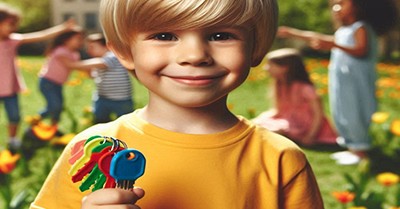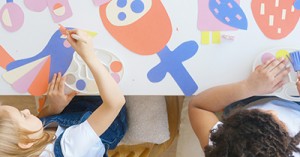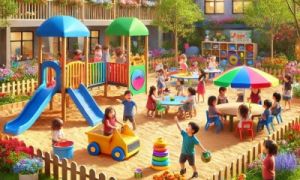Quality Area 5: Relationships with Children is fundamental in early childhood education as it lays the groundwork for a nurturing and supportive learning environment. Here are some key terms and concepts central to this quality area.
Secure Attachment: The foundation for healthy development, secure attachment refers to the bond that forms when children feel safe, understood, and cared for by a consistent adult. This trust encourages exploration and learning. For example:
- An educator greets each child with a warm smile and a personalized welcome gesture every morning. Over time, the child begins to look forward to these personalized interactions, knowing they are valued and safe in this environment
Responsive Interactions: This involves being tuned in to children’s verbal and non-verbal cues and responding promptly and appropriately. Educators model active listening and empathy, which reinforces a child’s confidence and emotional well-being. For example:
- When a child excitedly points out a bug during outdoor play, the educator crouches to the child’s level, listens actively, asks questions about the bug, and even suggests looking up a fun fact together. This real-time engagement shows the child that their curiosity is appreciated and encouraged.
Trust & Respect: Fundamental to relationship building, these elements ensure that children feel valued and understood. When educators consistently show respect for each child’s individuality, it promotes an environment where every child feels secure enough to express themselves. For example:
- If a child becomes upset after a disagreement with a peer, an educator listens without immediate judgment, acknowledges their feelings with phrases like “I see you’re feeling sad about what happened,” and collaborates with the child on ways to resolve the conflict. This respectful approach builds trust over time.
Positive Engagement: This centers on interactions that are supportive, affirming, and collaborative. By engaging children through play, conversation, and shared experiences, educators help cultivate a sense of belonging. For example:
- During a group art project, an educator encourages each child to add their unique touch. They circulate among the children, offering genuine praise for each idea contributed, which not only boosts the child’s creative confidence but also builds a sense of collective belonging.
Emotional Regulation & Co-Regulation: Educators support children in managing their emotions. This might involve modeling calming techniques or guiding children through strategies that help them navigate strong feelings, fostering the ability to self-regulate over time. For example:
- When a child struggles with frustration during a challenging activity, the educator offers a calm space and guides the child through simple breathing exercises. By modeling a calm demeanor, the educator is co-regulating the child’s emotions until the child feels ready to try again independently.
Consistency & Predictability: Establishing routines and clear expectations creates a stable environment. Consistent responses from adults reinforce trust and help children feel secure in knowing what to expect. For example:
- A classroom’s daily routine is clearly outlined—with established signals for transitions such as a particular song for cleanup time or a visual timetable displayed on a wall. This predictability reduces anxiety and helps children manage transitions smoothly throughout the day.
Cultural Competence: Recognizing and honoring the diverse cultural, linguistic, and social backgrounds of children ensures that relationships are built on mutual respect. This includes integrating varied cultural perspectives into daily interactions and curricula. For example:
- An educator includes a “culture day” where children and families are invited to share stories, foods, customs, or traditional songs from their cultural backgrounds. This practice not only enriches the classroom experience but also teaches children to appreciate diversity and build inclusive relationships.
Reflective Practice: Educators regularly evaluate their own interactions, questioning how their behaviors, biases, and practices influence their relationships with children. This reflective process is key to continual improvement and empathy.
- After a challenging incident, an educator takes time to reflect on the interactions and considers alternative approaches for the future. They might journal about the experience and later discuss it in a team meeting with colleagues, seeking feedback to adapt their practice.







 Here is the list of the EYLF Learning Outcomes that you can use as a guide or reference for your documentation and planning. The EYLF
Here is the list of the EYLF Learning Outcomes that you can use as a guide or reference for your documentation and planning. The EYLF The EYLF is a guide which consists of Principles, Practices and 5 main Learning Outcomes along with each of their sub outcomes, based on identity,
The EYLF is a guide which consists of Principles, Practices and 5 main Learning Outcomes along with each of their sub outcomes, based on identity, This is a guide on How to Write a Learning Story. It provides information on What Is A Learning Story, Writing A Learning Story, Sample
This is a guide on How to Write a Learning Story. It provides information on What Is A Learning Story, Writing A Learning Story, Sample One of the most important types of documentation methods that educators needs to be familiar with are “observations”. Observations are crucial for all early childhood
One of the most important types of documentation methods that educators needs to be familiar with are “observations”. Observations are crucial for all early childhood To support children achieve learning outcomes from the EYLF Framework, the following list gives educators examples of how to promote children's learning in each individual
To support children achieve learning outcomes from the EYLF Framework, the following list gives educators examples of how to promote children's learning in each individual Reflective practice is learning from everyday situations and issues and concerns that arise which form part of our daily routine while working in an early
Reflective practice is learning from everyday situations and issues and concerns that arise which form part of our daily routine while working in an early Within Australia, Programming and Planning is reflected and supported by the Early Years Learning Framework. Educators within early childhood settings, use the EYLF to guide
Within Australia, Programming and Planning is reflected and supported by the Early Years Learning Framework. Educators within early childhood settings, use the EYLF to guide When observing children, it's important that we use a range of different observation methods from running records, learning stories to photographs and work samples. Using
When observing children, it's important that we use a range of different observation methods from running records, learning stories to photographs and work samples. Using This is a guide for educators on what to observe under each sub learning outcome from the EYLF Framework, when a child is engaged in
This is a guide for educators on what to observe under each sub learning outcome from the EYLF Framework, when a child is engaged in The Early Years Learning Framework describes the curriculum as “all the interactions, experiences, activities, routines and events, planned and unplanned, that occur in an environment
The Early Years Learning Framework describes the curriculum as “all the interactions, experiences, activities, routines and events, planned and unplanned, that occur in an environment


